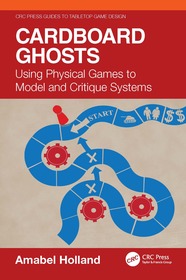
Worldbuilding for Game Designers
Sorozatcím: CRC Press Guides to Tabletop Game Design;
-
20% KEDVEZMÉNY?
- A kedvezmény csak az 'Értesítés a kedvenc témákról' hírlevelünk címzettjeinek rendeléseire érvényes.
- Kiadói listaár GBP 125.00
-
59 718 Ft (56 875 Ft + 5% áfa)
Az ár azért becsült, mert a rendelés pillanatában nem lehet pontosan tudni, hogy a beérkezéskor milyen lesz a forint árfolyama az adott termék eredeti devizájához képest. Ha a forint romlana, kissé többet, ha javulna, kissé kevesebbet kell majd fizetnie.
- Kedvezmény(ek) 20% (cc. 11 944 Ft off)
- Kedvezményes ár 47 775 Ft (45 500 Ft + 5% áfa)
Iratkozzon fel most és részesüljön kedvezőbb árainkból!
Feliratkozom
59 718 Ft

Beszerezhetőség
Becsült beszerzési idő: A Prosperónál jelenleg nincsen raktáron, de a kiadónál igen. Beszerzés kb. 3-5 hét..
A Prosperónál jelenleg nincsen raktáron.
Why don't you give exact delivery time?
A beszerzés időigényét az eddigi tapasztalatokra alapozva adjuk meg. Azért becsült, mert a terméket külföldről hozzuk be, így a kiadó kiszolgálásának pillanatnyi gyorsaságától is függ. A megadottnál gyorsabb és lassabb szállítás is elképzelhető, de mindent megteszünk, hogy Ön a lehető leghamarabb jusson hozzá a termékhez.
A termék adatai:
- Kiadás sorszáma 1
- Kiadó CRC Press
- Megjelenés dátuma 2025. június 1.
- ISBN 9781032862293
- Kötéstípus Keménykötés
- Terjedelem298 oldal
- Méret 229x152 mm
- Súly 710 g
- Nyelv angol 667
Kategóriák
Rövid leírás:
Our modern world is dominated by giant media companies, and increasingly they don’t so much sell story, characters or gameplay as they do their setting. Fictional worlds are big business and represent big value to companies and audiences alike, and they are increasingly expected and demanded by both.
TöbbHosszú leírás:
Our modern world is dominated by giant media companies, and increasingly they don’t so much sell story, characters or gameplay as they do their setting. Fictional worlds are big business and represent big value to companies and audiences alike, and they are increasingly expected and demanded by both. As yet, however, the art of building worlds has only been taught to writers of novels or films. The same worlds are frequently used across different modes of media, but successfully adapting them to games or building them for this purpose requires a specific approach.
Unlike all other artforms, games mandate participation, with the audience stepping into the world of the game and taking on the roles that the rules and pieces demand of them. Likewise, whenever an audience engages with a fictional world they are inherently playing a game of make‑believe and imagining themselves within a different context. This makes worldbuilding and gaming a perfect match, with each element giving more power to the other. This book unlocks exactly how the two disciplines are entwined and work together and how a designer can harness that synergy to the best effect.
This text is composed of short, focussed chapters that explain every step of building a compelling world, from getting your first ideas to moving towards publication. It also provides a deeper understanding of the how and why of world creation and why worlds have so much power over us as players and as people.
Features:
- Covers every step of world creation from getting ideas to seeking publication
- Comprehensive analysis of the field
- Inspirational tricks to break blocks or find new angles
- Practical exercises at the end of every chapter
- Simple and accessible material for every kind of game or game designer
“Steve Dee’s book is the best work on worldbuilding since the Hadean Eon.” – Dan Abnett, New York Times bestselling author and writer of wrongs.
“I can count on Steve always to deliver on the creativity. He has a knack for digging in deep and coming up with something marvelous! When it comes to worldbuilding, he knows his subject and would-be game designers can learn a lot from him.” – Robert J Schwalb, Game Designer (Shadow of the Demon Lord, Dungeons & Dragons, Warhammer Fantasy Roleplay)
TöbbTartalomjegyzék:
Part One: General Principles, 1. Worlds Must Be Built to Purpose, 2. Setting Exists To Communicate Mechanics, 3. Worlds and Games Are Built On Narratives, 4. World Building is Character Building, 5. Astrology not Astronomy, 6. Realism and Believability, 7. Keep Asking Questions, 8. Question Everything, 9. Reality is Your Muse, 10. Keeping Asking People, 11. Rigidly Defined Areas of Doubt and Uncertainty, 12. Embodiment and Anthropology, Part Two: Breaking Ground, 13. Extrinsic and Intrinsic Worldbuilding, 14. Start Small and End Small, 15. Go Big and Go Home, 16. The Richard Scarry Interrogative, 17. Gods and Monsters, 18. The Map is not the Territory, 19. Genesis and the Bible, 20. Top Down…, 21. …and Bottom Up, 22. The Spongebob Technique, 23. Good vs Evil and Other Popular Brands, 24. Psychographics and Psychodrama, 25. Plot Armour and Railroading, Part Three: Developing Your World, 26. Never Say Never Again, 27. Pipe and How To Lay It, 28. The Slice of Life, 29. Signs and Signifiers, 30. Synecdoche and Statistics, 31. A Game Is A Map, 32. Teaching and Example, 33. The Jimmy Olsen Blues, 34. The Ray Arnold Principle, 35. Filling the Fractal, 36. Borrowing, Stealing and Appropriating, 37. Lawyers, Puns and Money
Több





